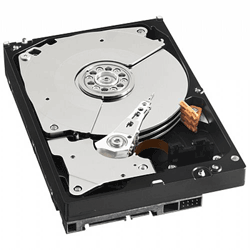Western Digital to launch helium-filled hard disk drives
Change promises big boost in capacity, performance
In perhaps one of the most drastic moves the company’s ever made to the design of its hard disk drives (HDDs), Western Digital is gearing up to launch a line of drives filled with helium — as opposed to air — which will drastically reduce internal friction and, in turn, lower the device’s power consumption 23% while increasing its capacity 40%.

Western Digital will launch a line of helium-filled hard disk drives next year.
The new line of HDDs will be ready next year.
A sealed deal
The reason behind this change is pretty simple: helium’s density is one-seventh that of air. The problem has always been figuring out a way to keep the helium in.
The new line of HDDs will be hermetically sealed which, it turns out, offers its own additional benefits: it keeps humidity and other contaminates out.
Looking a little closer at the combined benefits of helium-filled, hermetically sealed drive, the less drag means the drive can operate at temperatures four to five degrees (Celsius) cooler than modern-day 7200 rpm drives, while being hermetically-sealed means that the drive can operate in more severe environmental conditions, too.
All of this is according to Brendan Collins, vice president of product marketing at Western Digital subsidiary Hitachi Global Store Technologies (HGST), the company responsible for developing the 3.5-inch data center drives.
“The industry has been trying to make this work for the past 10 years. They’ve been trying to ensure that the gas doesn’t leak and that the drives can be efficiently produced in mass volume. That’s the key to our proprietary technology,” Collins said.
More of a platform, less of an individual product
The helium-based HDDs will be more of a technology platform rather than an individual product for sale. Specifically, the drives will be targeted for use in public cloud computing systems and corporate data centers.
“We believe the technology will be around for the next 10 years and will be the foundation of cloud-based storage in the data center,” Collins said.
To that regard, the drives will allow HGST to increase a platform’s overall platter count from five to seven, and increase its density, too, by allowing more tracks per square inch.
At present, HGST drives offer up to 4TB of capacity on five internal platters. While the company would not say what capacity the helium-filled drives will offer, it could be as much as 5.6TB based on the company’s estimate of a 40% increase over current technologies.
Plenty of other benefits to making the switch
According to HGST, the new seven-platter helium drives will weigh 29% less per terabyte of capacity than today’s five-platter drives. Breaking down the numbers, that means a seven-platter helium disk will weigh 690 grams — the same as today’s five-platter drives.
Also, due to the drag reduction, HGST’s helium drives will use 23% less spindle power to turn. A five-platter drive today draws 6.9 watts while idle. The 23% power reduction means the new seven-platter helium drives will draw 5.3 watts of power in the same state.
Collins added that the seven-platter, 3.5-in helium drives will also have a 50% lower cost per gigabyte than 2.5-in four-platter hard drives.
Less space
Given that these drives can be set up at a higher capacity, it will take less servers to fill the same data center. Collins gave the following example: a petabyte of data requires 20 servers using five-platter, 4TB drives. Using the company’s new seven-platter drives, the same amount of data can be stored in just 14 servers.
“Data centers are becoming more customized and using more open-source hardware and software,” he said. “We’re seeing a lot of cloud customers designing their own servers, file systems and software stacks.”
Speaking to this point, Collins added the fact that up to 40% of the costs in new cloud based data centers will be attributed to operational costs such as power use and floor space. Today, the bulk of data center costs are capital expenditures, including hardware purchases.
“This is driving a lot of opportunities to differentiate products in the cloud,” he said. “The attributes of the sealed drive platform make it the ideal foundation for bulk and cold storage applications in enterprise and cloud datacenters.”
Outlook
Researchers have been trying to figure a solution to the whole how-do-we-keep-the-helium-from-leaking conundrum for a long time now, and it’s great to see it finally get figured out.
Make no mistake though, while there are plenty of cost-cutting benefits to this new technology, there will be a high upfront price to pay, as helium is much more expensive than air.
A stiffer, diffusion-proof disk structure is likely to drive costs higher as well.
The good news, though, is that with greater volume, customers will likely see costs reduced over time. ■
Story via: pcworld.com
Advertisement
Learn more about Electronic Products Magazine





